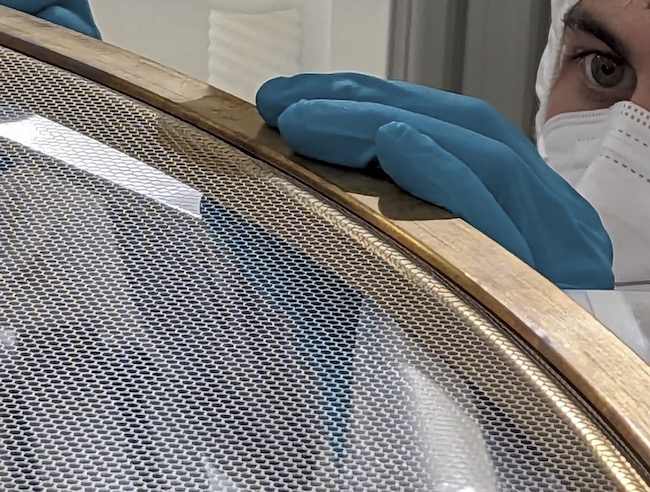
The NEXT-100 experiment is the third iteration of the NEXT detection concept. The detector is a 1:2 scaling up in size of its 5 kg predecessor, NEXT-White.
NEXT-100 assembly was completed in 2024 at the Canfranc Underground Laboratory (LSC) and the detector is currently acquiring data with xenon. The aims of the experiment are:
- Provide a competitive search for neutrinoless double beta decay in Xe-136.
- Validate the background model used in NEXT-White at a 100 kg scale.
- Demonstrate and understand detector capabilities at the 100 kg scale.
NEXT-100 is an asymmetric High Pressure Gaseous Xenon Time Projection Chamber (HPGXe-TPC), employing photomultipliers tubes (PMTs) in the energy plane to reconstruct the energy of charged particles. Silicon photomultipliers (SiPMs) are used to reconstructed the ionization trail of the particles in the xenon. The detector will contain 100 kg of xenon gas operating at 15 bar, occupying an active volume of roughly 1 m diameter by 1 m length.
The detector is comprised of multiple layers. The outermost layer is the vessel, made of stainless steel, which was designed to withstand high pressure. This layer is followed by a 12 cm thick copper shield, which will reduce external background. Next, in the barrel region, is the field cage, where an electric field Is applied to drift secondary charged particles towards the tracking plane. An anode mesh is placed 1 cm from a gate. This generates a relatively strong electric field, allowing for electroluminescence (EL) to occur. 52 rings and 150 resistors evenly distributed across the drift and buffer regions to ensure uniformity. The inside of the field cage will be lined with polytetrafluoroethylene (PTFE) panels coated in tetraphenyl butadiene (TPB). The PTFE panels will optimize light collection via diffuse reflectivity, whereas the TPB is used as a wavelength shifter to shift the 170 nm scintillation light, emitted during the de-excitation of xenon atoms, to light in the visible spectrum (420 nm), which is more suited to the quantum efficiency of the PMTs and SiPMs.

The field cage is flanked by the two measuring planes. On the side of the cathode is the energy plane, which consists of 60 PMTs (compared to the 12 PMTs used in NEXT-White), isolated from the gas by sapphire windows, also coated with TPB. On the opposite side of the field cage, 1cm from the EL region, is the tracking plane. The tracking plane is made up of 3584 SiPMs (1792 in NEXT-White) assembled in 56 8×8 DICE boards. Each DICE board is covered with a TPB coated Teflon mask, to collimate light and enhance light collection in the energy plane.
External backgrounds are reduced by a lead castle surrounding the detector. In addition to this, the 800 m of rock above the detector allows for protection from cosmic radiation. Finally, a radon abatement system used at LSC delivers 222-Rn-free air.
NEXT-100 is expected to be able to provide a background rate of 10-3 counts / keV / kg / year and be able to reach a sensitivity to the neutrinoless double beta decay half life of 6 x 1025 years at the 90% CL for three years of data taking.

